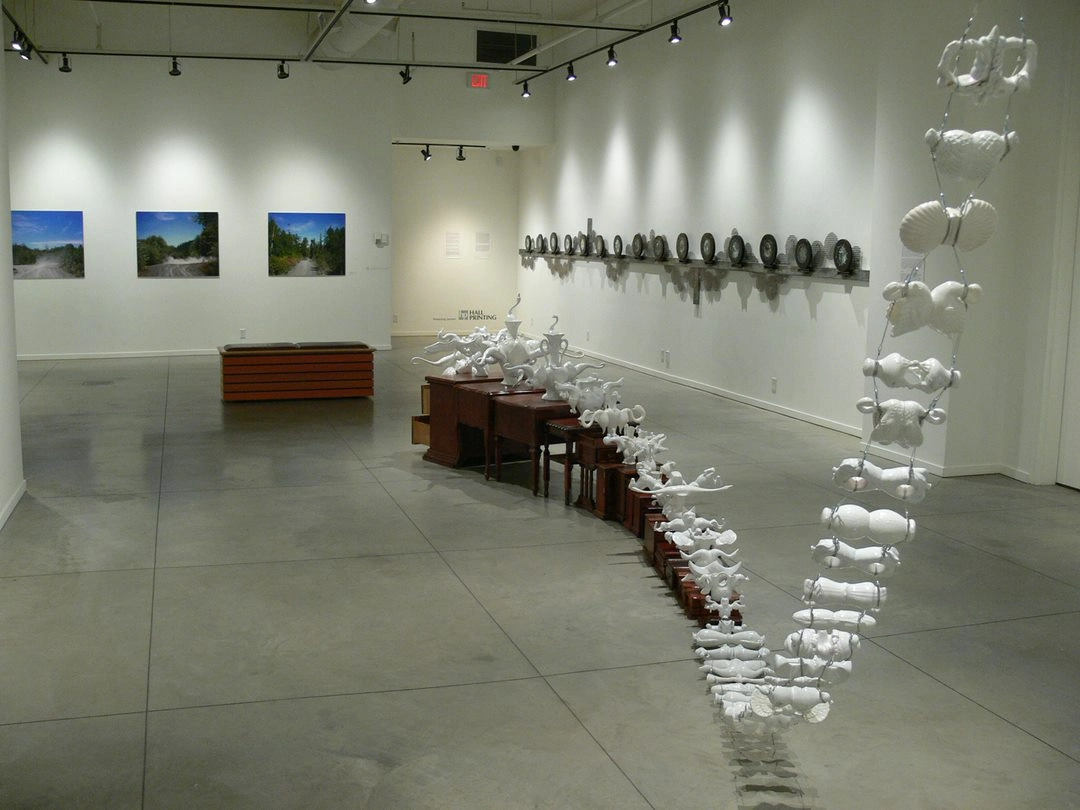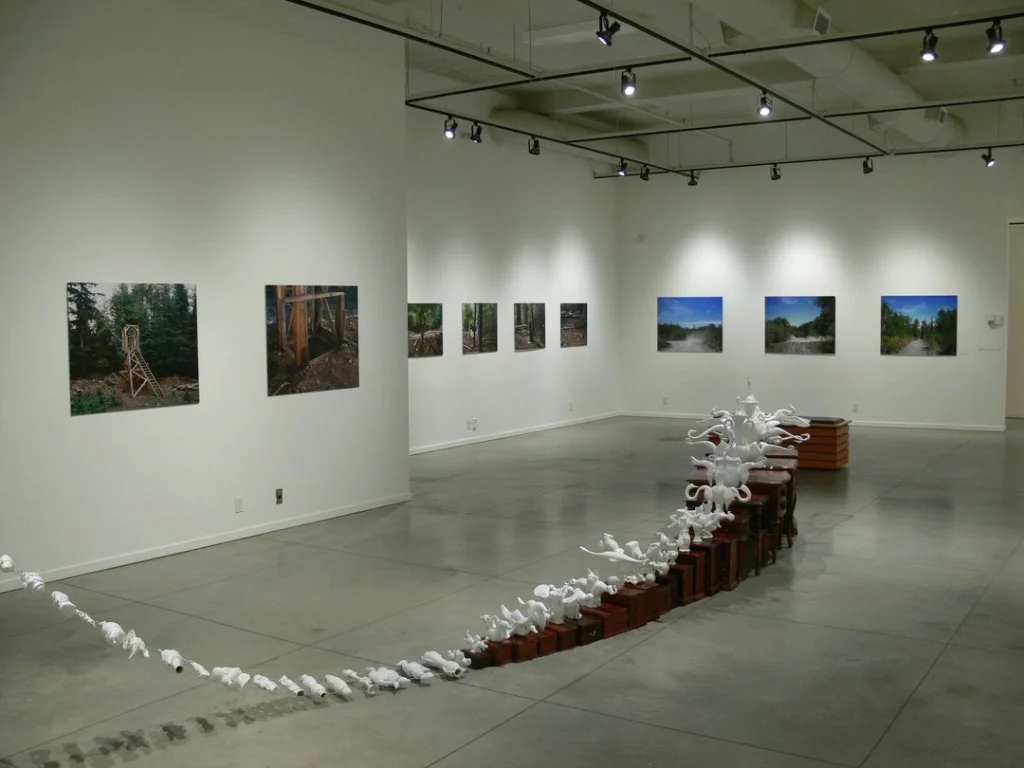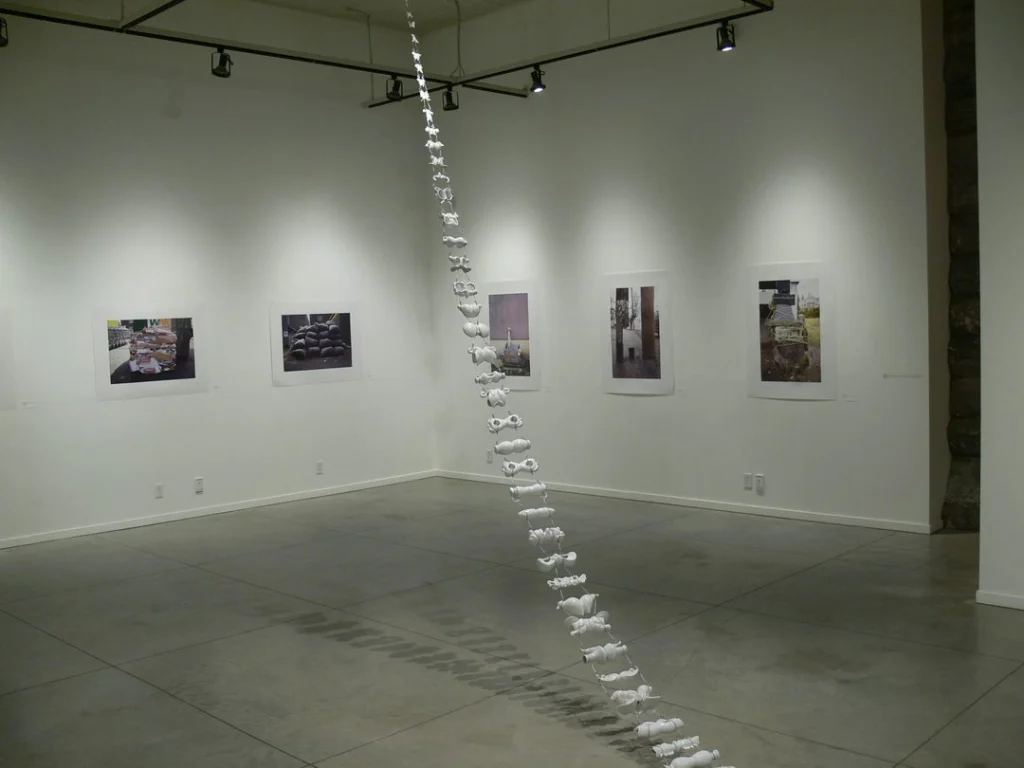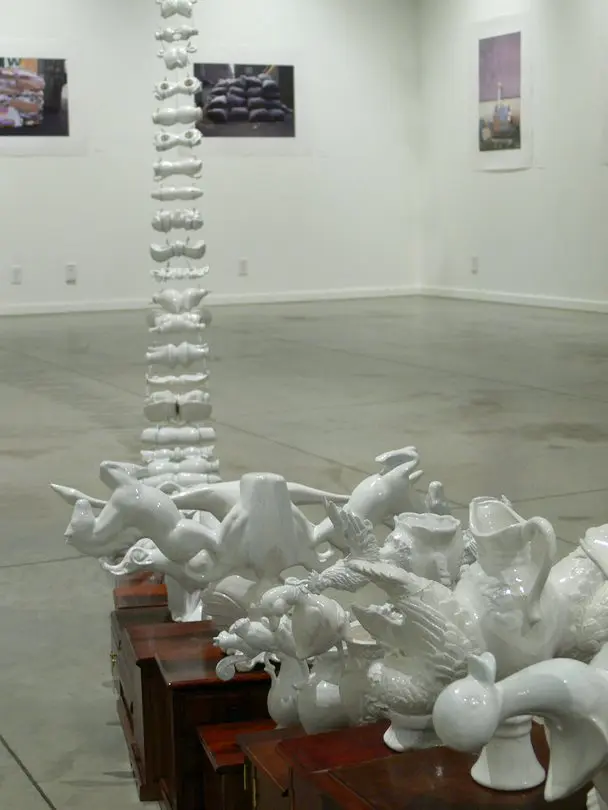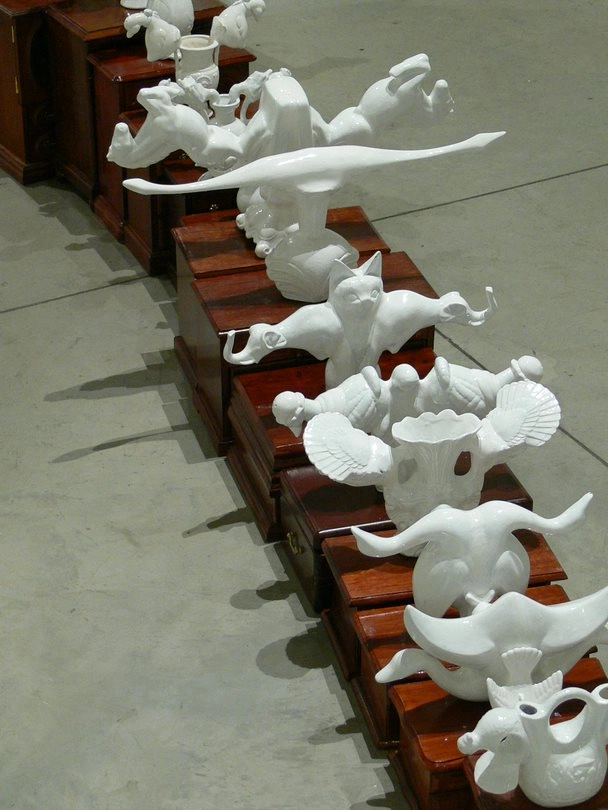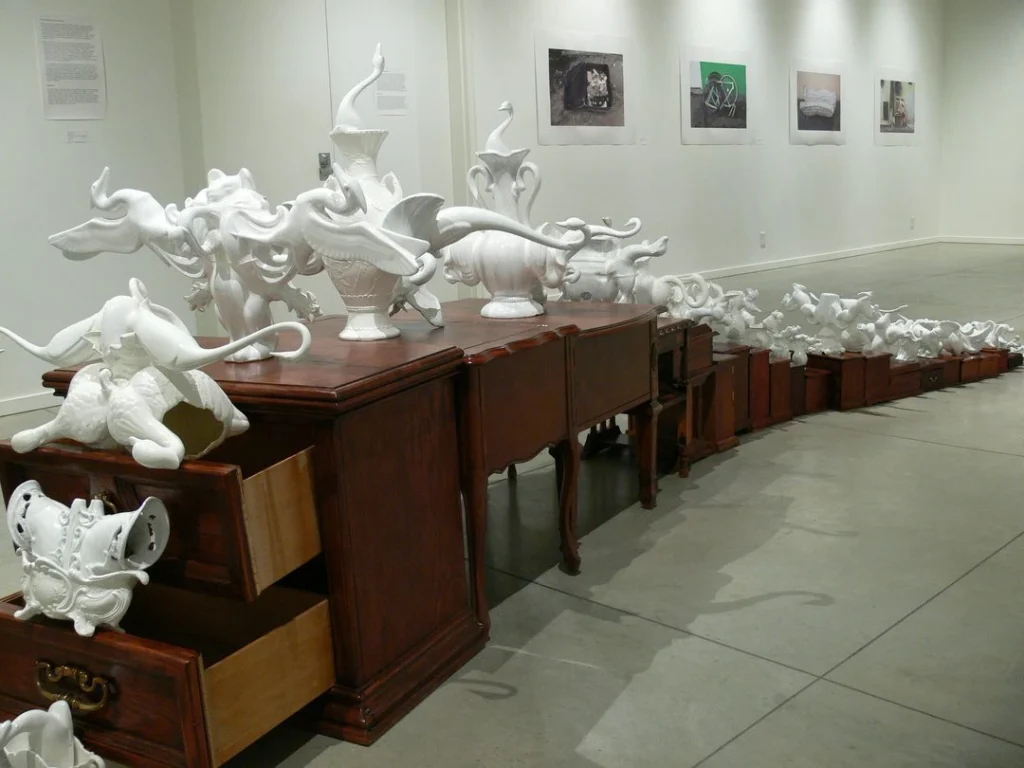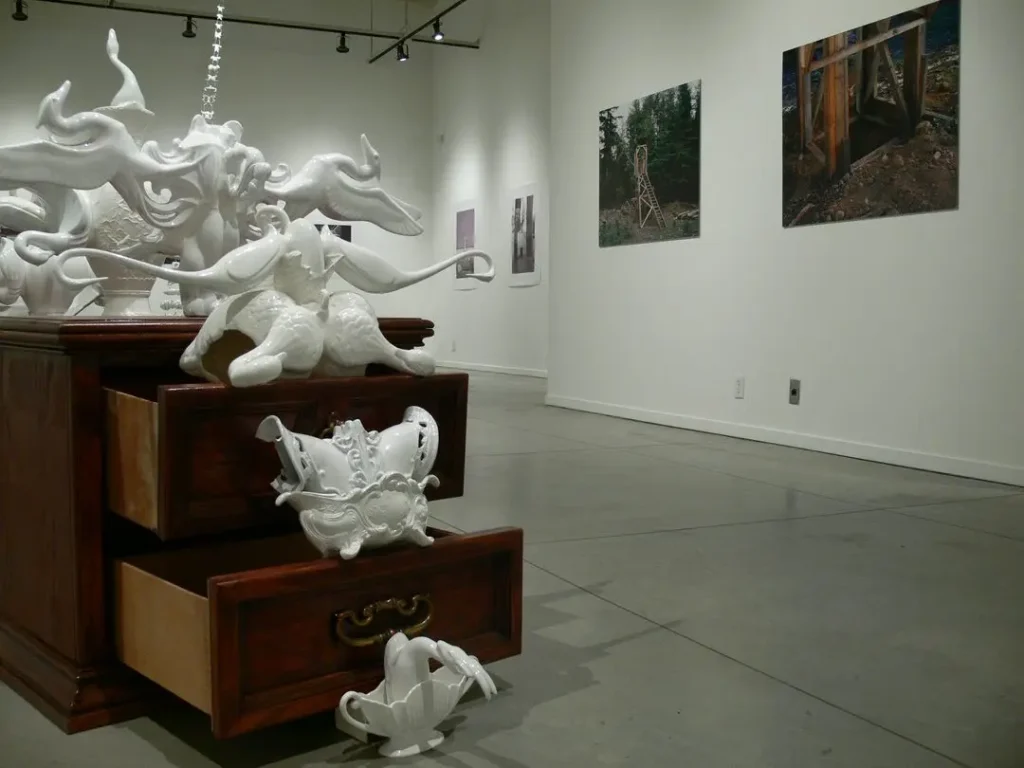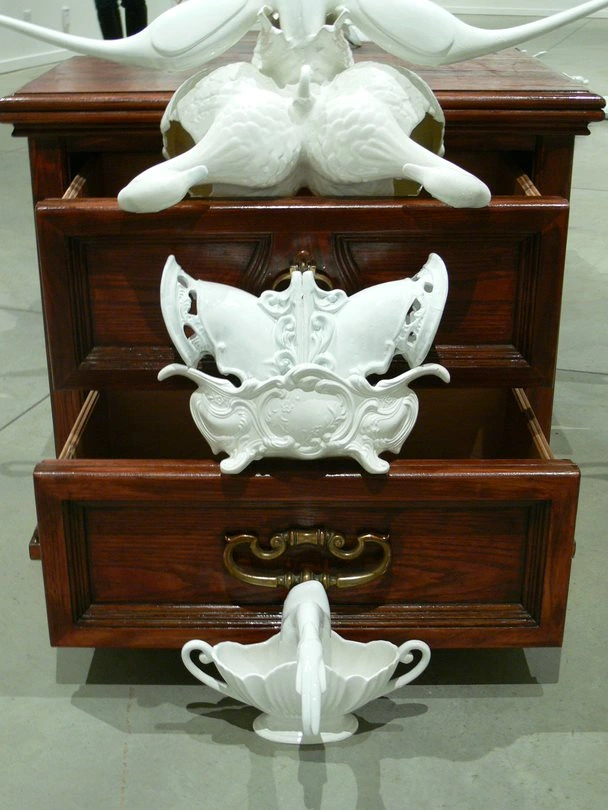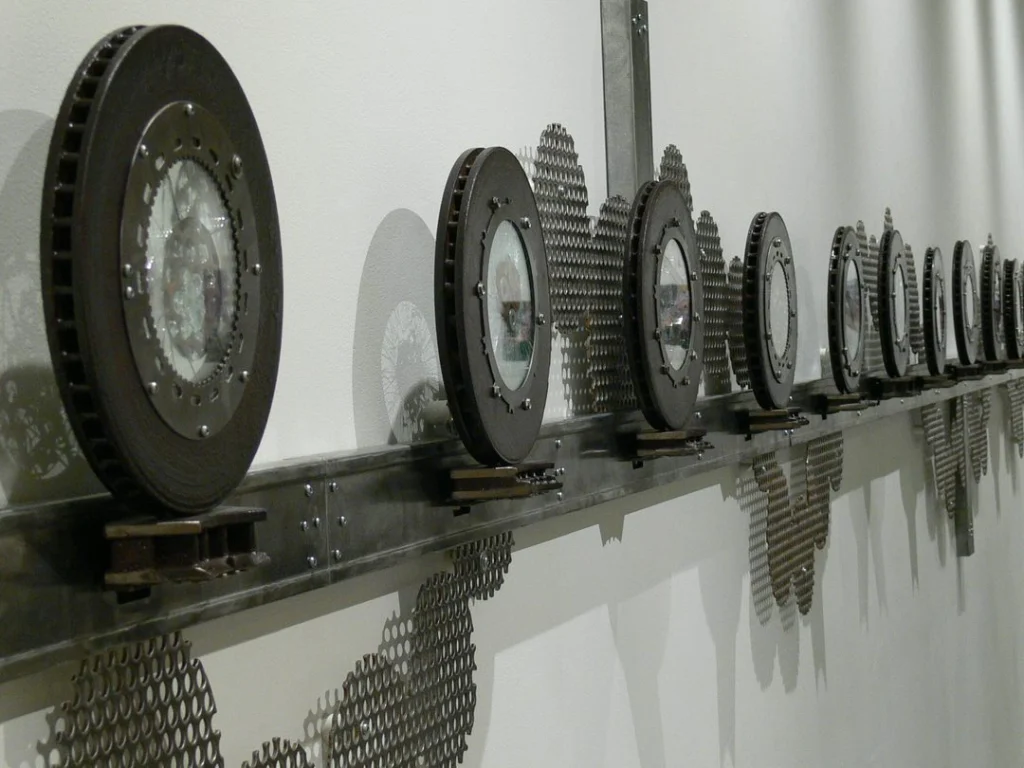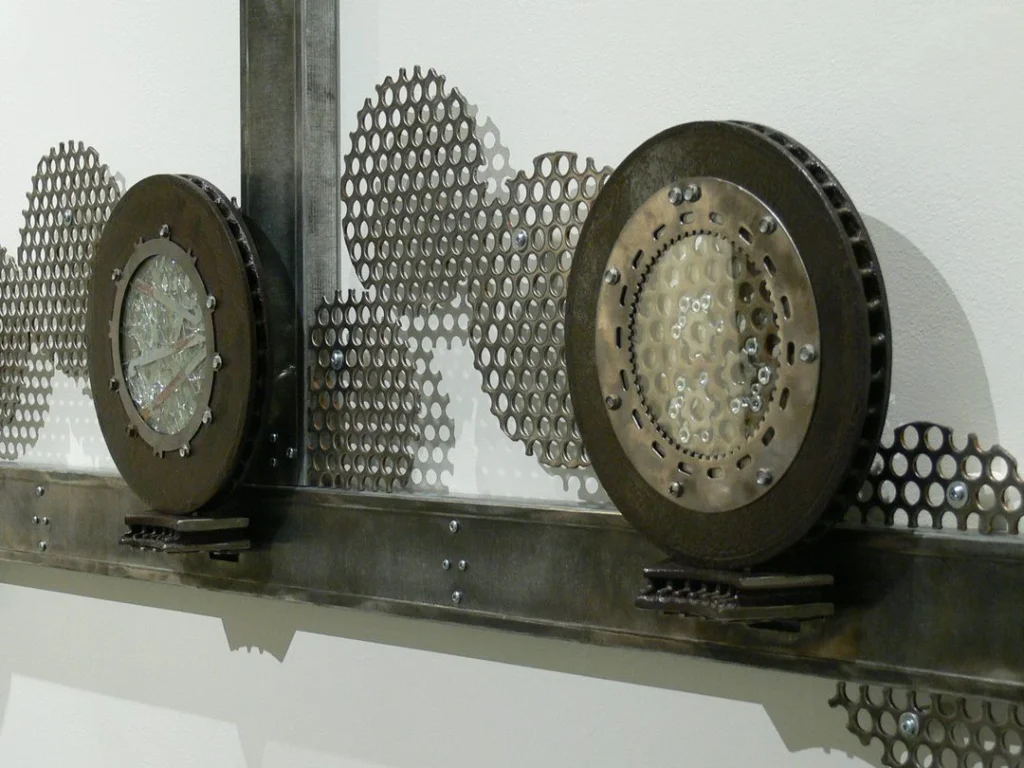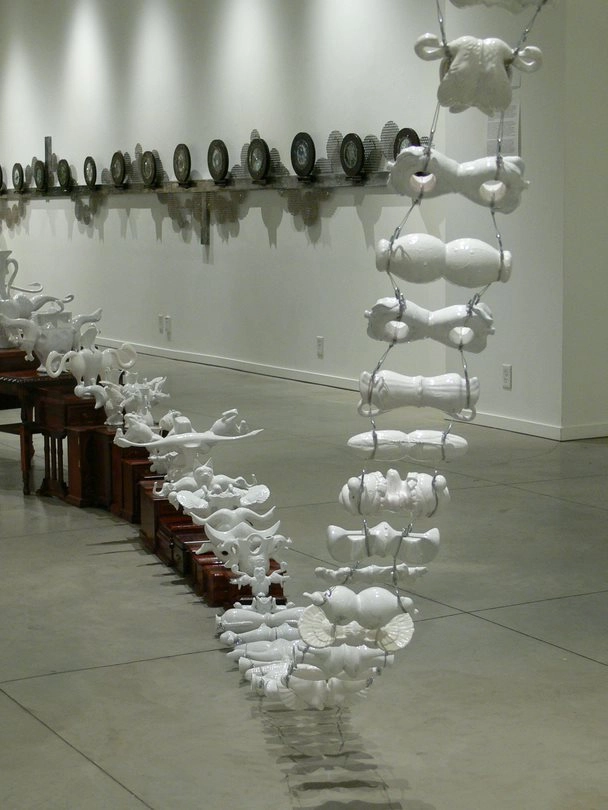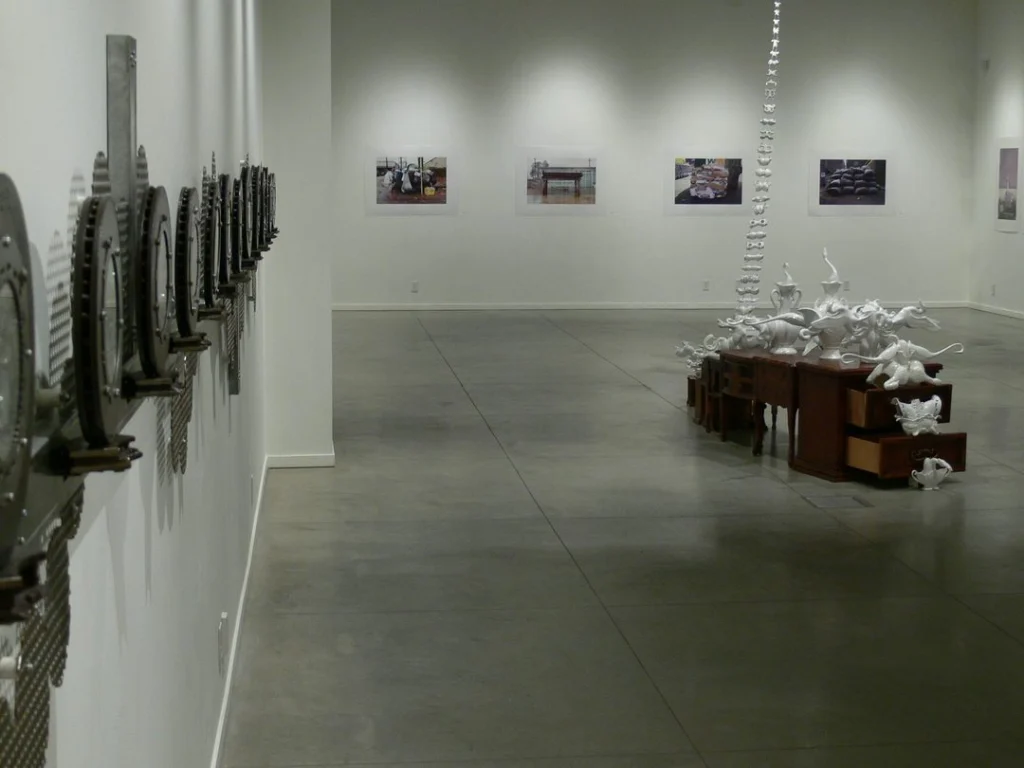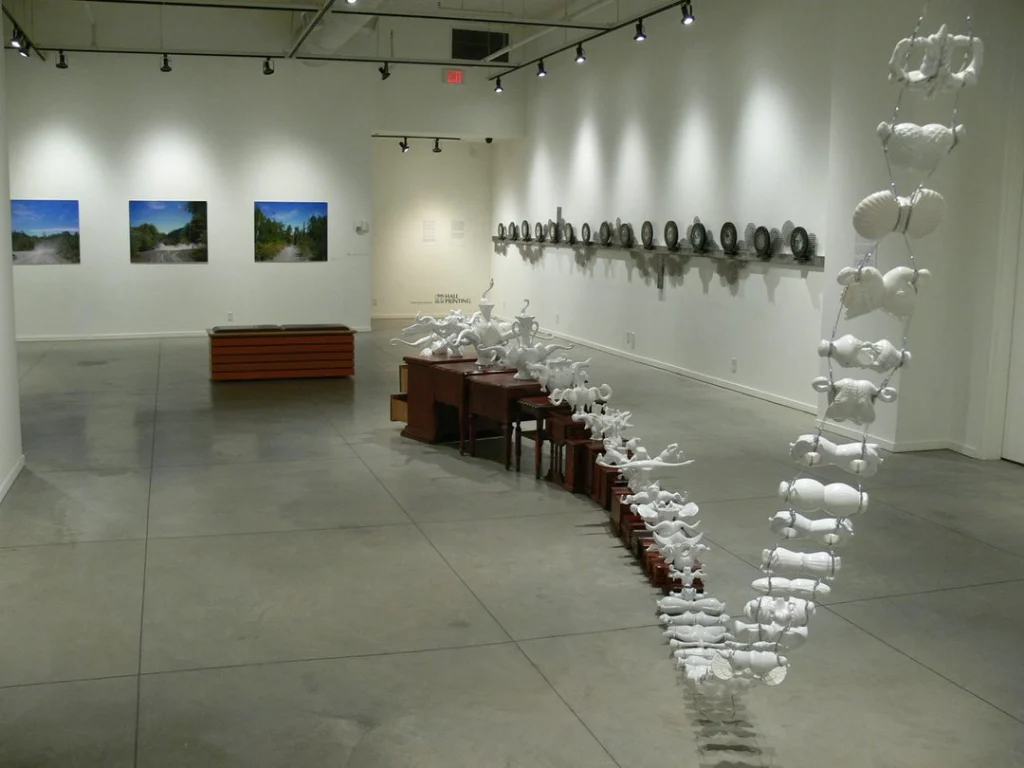Shyra De Souza, Mark Mizgala, Nate and Cedric Bomford, Brent Bukowski: Found
Curated by Rod Taylor
This exhibition looks at five artists whose work involves reused or recycled material. Through reshaping, recreating and reframing, they offer new perspectives on what photographer Roy Arden once described as “the landscape of the economy”. In different ways, the work touches on where it comes from, what we do with it, and what happens when we’re done with it.
In The Claim, brothers Nathan and Cedric Bomford layer their own actions and structures on top of existing (presumably industry-related) interventions in the landscape, in the form of access roads, tree stumps and surveying tape. The photographs not only document the pseudo-historical mining structure they created (with new and re-used material), but place it within a wider context of a landscape already shaped by modern industrial activity.
Recycled metal and glass have long been the foundation of local artist Brent Bukowski’s practice. As raw material for his work they aren’t always recognizable, but they have the patina of use and the appearance of being made for a particular function. Drawing directly on the artistic tradition of assemblage, the elements in By-product are made almost exclusively from discarded material. Interestingly, they are also left-overs from a recent public art commission he completed here in Nelson – a “waste not want not” approach that becomes an expression of his own personal values of sustainability and economy.
With Phantom Limb, Shyra De Souza also draws on the tradition of assemblage, using thrift store ceramics, furniture and other finds as her medium. Left behind by trends and fashion, they are given new life within the skeletal, almost insect-like form of the piece. Deliberately ambiguous, Phantom Limb resists single interpretations, but the familiarity of its individual parts invite you to consider it further.
In his Monument series of photographs, former commercial photographer Mark Mizgala brings his own brand of back-alley realism to the things we throw away. The objects they depict are not altered or staged in any way, with his intervention limited to choosing and framing the compositions. The photos become the only lasting evidence of these temporal and at times unlikely compositions, transforming the mundane into something almost poetic when viewed in this context.
Individually, the work you see here speaks in various ways to aspects of our consumption. Together, it forms a kind of mini life-cycle of our material culture, from extracting the raw material, to its use and eventual disposal. Throughout, these artists ask us to reconsider what we think we know, offering other ways of seeing things by reframing the familiar. By doing so, they not only highlight the transient usefulness of these artifacts of human activity, but perhaps also encourage us to look twice at what we throw away ourselves.
The opening reception of Found will also be part of Blue Night, a multi-venue evening of free art openings featuring the work of 18 artists at nine venues in Nelson.
Brent Bukowski
Brent Bukowski is an artist that works with reclaimed materials. He reanimates discards into compositions that explore environmental and historical themes. His work achieves a high level of detail and has been applied to a variety of sculptural forms: series work, installation, architectural, set design and public art.
Born and raised in Regina, Saskatchewan (1968), he has lived on a acreage in the mountains of British Columbia since 1992— where he and his partner, artist/curator Arin Fay, have designed and constructed their house and gardens and have raised two amazing children.
Artist’s Statement
I recently completed a public commission for the City of Nelson, BC, in which I designed, constructed and installed a 30 panel sculptural bridge railing running 135 feet. The theme of the design focused upon what has crossed the creek over the last century, resulting in a meandering array of regionally reclaimed wheels and cogs. As with any large scale project I have worked on, throughout the rigours of production, designs outside the work in progress are revealed. I find myself in a unique position: the designs I have accumulated focus upon the massive quantity of by-product generated from the bridge railing commission. I have over 400 glass-ready cast iron frameworks from the cross-sectional cuts of brake rotors/drums; buckets filled with the cut-offs of mining, forestry, agricultural, automobile, and bicycle components; and an exact silhouette in 10 gauge perforated sheet metal of the entire run of the sidewalk-side of the sculptural core. As a self described bottom feeder, working man, day dreamer, the notion of further processing the by-product generated from materials already once reclaimed, appeals to me on many levels. It speaks volumes in terms of sustainability, a theme that is consistent throughout my work in the visual arts. Preliminary design work has resulted in numerous design possibilities of varying scale, complexity and application; the first of which is included in this exhibition–a numbered series of small sculpture titled by-product.
Cedric Bomford
Cedric Bomford, born in Vancouver in 1975, currently lives and works in Winnipeg, Manitoba where he is an Assistant Professor in the School of Art. His installation and photographic work has been exhibited internationally and he has participated in residencies in Europe, Asia, Australia and North America. Cedric holds an MFA from the Malmö Art Academy (2007) and a BFA from Emily Carr University (2003). His work often focuses on the power dynamics established by constructed spaces and takes the form of large-scale rambling improvisational architectural installations. The projects follow a methodology he calls ‘thinking through building’ in which construction takes on an emergent quality rather than an illustrative one. Concurrent to this installation work is a rigorous photographic practice that oscillates between research for and documentation of the installation works.
While the majority of his projects are solo efforts, Bomford often works collaboratively with a number of different partners including his brother Nathan, father Jim and with other artists such as: Verena Kaminiarz, Mark Dudiak and Carl Boutard. Currently he has exhibitions open in London (MOT Intrnational with Nathan Bomford) and at the Esker Foundation in Calgary, Alberta. Upcoming projects are planned for this year with Other Sights for Artists’ Projects in Vancouver (public art project with Nathan and Jim Bomford) and Touchstones Museum in Nelson, BC (with Nathan Bomford).
Nathan Bomford
Born 1977 in Kamloops, Nathan Bomford is currently based in Shawnigan Lake, British Columbia. Nathan received an MFA from the University of Victoria in 2006, a BFA with a major in photography from the Nova Scotia College of Art and Design, in 2003, and a DipVA from Camosun College in 2001. He has exhibited in solo and group exhibitions internationally. Much of his recent work has been completed in collaboration with his brother Cedric Bomford and his father Jim Bomford.
Much of Nathan’s practice focuses on documentation and story-telling as well as local histories and vocations of physical labour. His large-scale installation work (often in collaboration with his Father and Brother) explores relationships of power inherent in the built, physical environment
Mark Mizgala
Mark Mizgala is a visual artist based in Vancouver, Canada. Mizgala was born in Montreal and graduated from OCAD University in 1987. He then attended film school at Simon Fraser University School for the Contemporary Arts where he was awarded scholarships for two consecutive years. Upon graduation, Mizgala began a career as an advertising art director and went on to win numerous international awards for creative excellence including Gold and Bronze Lions from Cannes, France. Other awards include The New York One Show; The Clio Awards, Chicago; The Ad and Design Club, Toronto; The Lotus Awards, Vancouver; Communication Arts Magazine, Menlo Park, California; Applied Arts Magazine, Toronto and Archive Magazine, Vienna, Austria. In 1998, he was ranked the number two art director in Canada according to Strategy Magazine’s Creative Report Card.
Mizgala has exhibited widely since 2001 and his work is in collections throughout North America and Europe. In 2009, he became a full time visual artist working in both photography and painting. Mizgala was awarded British Columbia Arts Council Project grants in both 2016 and 2021. In 2020 and again in 2021, he received Canada Council for the Arts Research and Creation grants.
Artist’s Statment
In this series, I am photographing ready-made sculptures that I discover in
laneways and back alleys. I am struck by the care and attention with which waste
is placed, piled, and fastened. But these Monuments are not just about the
aestheticization of detritus: they echo an insidious truth about our consumption
behavior. The photographs represent a single moment frozen in time, but also
call to mind an entire system of production, distribution, purchase, and waste. I
frame my photographs without the human figure, but there is an ever-present
sense of human activity and our propensity to consume: items are endlessly
disposed, dumped, or decommissioned.
I am interested in the life cycle of these monuments, the narratives they recount,
and their transformation within the viewfinder. I am at once commenting on and
complicit in the consumption cycle through the simple act of taking the photo.
The artifacts go full circle: from market shelves, to homes, to alleyways, then
back as fetishized objects for consideration in a gallery setting
Shyra De Souza
Shyra De Souza is an interdisciplinary artist based in Calgary. She attended the Sculpture department at the Alberta College of Art & Design where she earned her Bachelor’s Degree in Fine Arts with distinction in 2006. As well as maintaining an artistic studio practice, she has undertaken several volunteer administration and board roles within the arts community, has been awarded a number of grants and residencies. Her range of work is mainly composed of sculpture, installation works, as well as animated film, but sometimes also leads to collage and drawing works. Her work has screened/exhibited across Canada, in the United States, and Europe.
Artist’s Statement
As the eye falls upon desirable material objects, the mind enters into a haptic process of touching the form from a distance, becoming a willing participant in the process of seduction, and generating a kind of understanding of the object as culturally predetermined. As human life is lived within the construct of various, layered communities, so is human understanding of the world experienced as a set of agreed upon rules and interpretations. I seek to disrupt and manipulate this intersubjective foundation of experience in order to draw attention to the process of meaning-making as it relates to contemporary material culture.
Much of my work is focused on the challenge of creating both a critical distance for the viewer of discarded, mass-produced objects I use in the work, while simultaneously drawing from, and building upon the extreme sensuality and allure of these objects. The intent is to remove the viewer from metaphorical and representational systems of thinking. I integrate multiple closed forms (usually second-hand, contemporary home décor items) into larger, open, layered, configurations. I place the resulting forms within a theatrical context that prompts a self-guided process of meaning-making in the viewer. The somewhat uncanny sensation of these reconfigured, less representational forms is intended to generate a sense of suspicion or disbelief of the form’s representational power.
In accomplishing these artistic goals, the viewer becomes a mandatory part of the work in that the actual artwork occurs where the art object and viewer intersect. My central method is that of collapsing reverence for these objects by indulging in them, heightening their effect. I personally experience their seductive characteristics, as I undertake an organic, adductive/reductive process in order to rearrange the objects into highly provocative forms. The resulting work accesses a form of visual communication akin to pseudo-science, mysticism, mythology, and other psychological phenomena. I wish to trigger a sort of cognitive equilibrium in the viewer where belief and non-belief are forever suspended.
